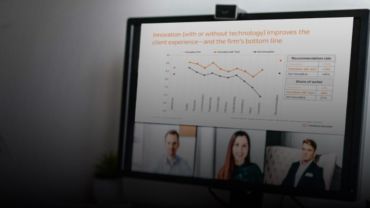At a recent gathering of law firm talent officers, a key question was: “We can all work remotely now, but how do we teach employees to work remotely well?"
At a recent gathering of law firm talent officers and directors from around the world, one key question seemed to hang in the air: “We can all work remotely now, but how do we teach employees to work remotely well?”
The group had come together at the Chief Talent Officer Roundtable to analyze what the future holds for talent management and firm management in the post-pandemic, remote working environment. And by taking a look at how some of the top talent officers are identifying skills gaps, managing their talent pool, and adapting to the current and future remote working environment, we got a glimpse into what gives the most dynamic law firms a competitive edge.
Custom approaches to skills gaps
As part of Thomson Reuters Sharplegal research, legal clients are asked about the most exceptional lawyers they have worked with and what makes those lawyers stand out. Many respondents strongly want lawyers who can provide practical advice, which helps clients proactively mitigate risk, while remaining responsive to clients’ needs. When those same stand-out lawyers were surveyed, they repeated a similar message.
The expectations that clients have of their lawyers today aren’t new, but as the data shows, business acumen, efficiency, and costs are coming into even greater focus. Indeed, data gleaned from Sharplegal, Stellar Performance, and Peer Monitor, shows that clients want value delivered consistently — and to do this, lawyers’ deep business understanding becomes regarded as the most important factor, followed by efficiency and cost-consciousness.
Not surprisingly, law firms are responding by “upping their business training and there’s demand even among partners,” according to one chief talent officer.
The most dynamic firms are using data to focus on perceived skills gaps across a number of areas, including matter management training, creating clear expectations for partners and associates around business development and business acumen, and sharing industry insights across the firm.
New ways to manage talent subcultures
Another topic discussed during the roundtable centered on how successful law firms managed their talent pools during the past year and the best ways to manage them going forward.
Several talent managers noted that the remote working environment has helped many firms learn what they already knew in concept. Because everyone can now literally see into the homes of their colleagues, it’s nearly impossible to ignore the need to do things differently. Most firms are being forced to recreate the organic conversations that happened naturally at work. “The overwhelming consensus is that change is real and happening,” said one roundtable attendee. “It will be harder to recruit and retain talent without change, and this flexibility is now expected.”
Roundtable attendees talked about intentionally pairing younger lawyers with more senior ones — and placing scheduled check-ins on their calendars rather than leaving it up to the lawyers to schedule — especially during the pandemic. Collaboration could no longer be assumed, but it’s also something that firms have increasingly decided to embrace to keep lawyers productive and happy.
Remote working has created more barriers for some workers, but less for others, the data shows. Within teams, there’s been a perceived increase in collaboration, according to Stellar Performance and Sharplegal data, with 80% saying it’s stayed the same or improved via remote working. However, between teams, 31% note that collaboration has deteriorated in the last year.
When reading between the lines, those lawyers who were more proactive, organized, and deliberate about collaboration thrived, whereas those who were more reactive, or in the moment, or relied on being in the same office, struggled.
So, from where do these contrary views stem? It’s both different mindsets and different approaches, the roundtable agreed. Thriving partners see the efficiency gains, utilize the tools available to them, and embrace the flexibility, while struggling partners have had difficulty interacting, managing, training, and collaborating, which often leads to less efficiency and less productivity.
Most of the attendees noted that much of this boils down to culture. “There’s a divergence of cultures, with micro- or subcultures in regions wanting different things,” said one attendee. “Some all want to be back in the offices, some want to stay at home. So, how do we find the balance?”
Adapt to changes in work environment
The digital environment has stretched many laws firms, and roundtable attendees noted both the gains and losses associated with new ways of remote working.
Technology and access to information have brought some teams and people closer together, but they have also necessitated investment in remote working training to prevent the loss of connection, work/life balance, and business development.
With the right strategies and access to industry insights and client data, however, dynamic law firms are overcoming the challenges of a fully remote workforce and leveraging the opportunities, efficiencies, and cost-savings it might offer.
If you’d like to know more about Thomson Reuters Sharplegal or Stellar Performance data or to be included in the next Chief Talent Officer Roundtable, please take a look at leadership and benchmarking services for large and midsize law firms.







